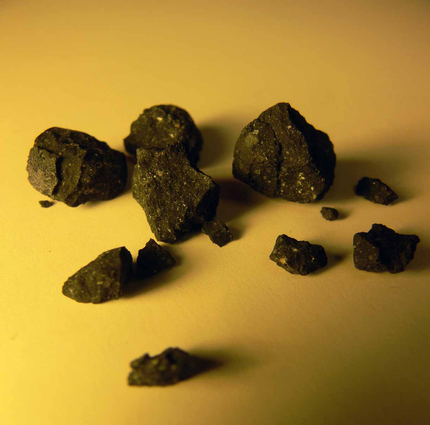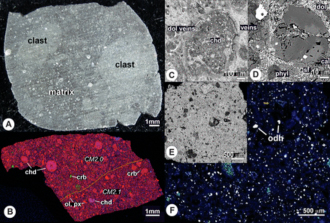Meteorite made up of rare early solar system material
It's all of the above: The Sutter's Mill Meteorite had the force of 4 kilotons of TNT upon descent and spilled samples of itself over the towns of Columa and Lotus in northern California when it hit Earth last spring.
And now a consortium of scientists including Lawrence Livermore's Gary Eppich of the Chemical Sciences Division has determined that the Sutter's Mill Meteorite (so named because one of the pieces fell at the site of the 1848 gold strike that triggered the California gold rush) is the most pristine sample yet collected of the rare Carbonaceous-Mighei chondrite(CM) class of meteorites. CMs contain largely unaltered materials from the dawn of the solar system.
Meteorites are the raw materials for planetary formation and are believed to contain particles of dust and small grains that were present in the early solar system and accreted to form primitive asteroids.
"It is awe-inspiring to work with such rare and interesting samples," Eppich said. "The Sutter's Mill meteorite contains material that pre-dates our sun, so these samples represent quite an impressive history. Meteorite studies provide valuable insight into the early history of the solar system, and it was a pleasure to play a small role in one such study."
Eppich's contribution focused on X-ray fluorescence spectrometry, which allowed the team to rapidly and non-destructively determine the major and trace element composition of the meteorite. This technique utilizes a powerful primary X-ray beam to cause the sample to produce secondary X-rays, which are characteristic of the chemical composition of the sample. These data were useful in characterizing the meteorite on the basis of its chemical composition, which in this case was a CM. "We believe we've identified the point of origin of these relatively pristine samples of solids formed in the early solar system," Eppich said.
The team, led by meteor astronomer Peter Jenniskens of the SETI Institute and NASA Ames Research Center, believe a good candidate source region for CM chondrites is the Eulalia asteroid family, recently proposed as a source of primitive C-class asteroids in orbit that pass Earth. Team members concluded that the meteorite was a composite of bits and pieces of different asteroids that collided in space.
The research appears in the Dec. 21 issue of the journal, Science .
Contact
Anne M Stark[email protected]
925-422-9799
Tags
Space securitySolar system
Physical and Life Sciences
Featured Articles









